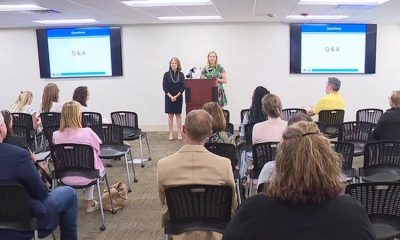Local News
What Arkansas homeschooling looks like

Jonesboro, Arkansas – Others view their home as the classroom, while some children board buses once more, and their parents resume driving them to school.
The Arkansas Department of Education reports that for the academic year 2021–2022, over 30,000 children in Arkansas were homeschooled.
In addition to teaching her younger child a little bit, Jamie Almond homeschools her kindergarten-aged daughter. Almond would prefer to teach from home even though it can be challenging.
“There are days where they don’t want to stop learning,” Almond said. “They’re like, can we do more.”
Though it required considerable thought and investigation, she ultimately decided to homeschool her children for a few reasons.
“Tailoring the needs of my child, being able to really see when something clicks with her, and really just teaching her how to love learning,” she explained.
Almond is a member of Northeast Arkansas Christian Home Educators, a homeschooling co-op where parents support one another in addition to discovering educational resources.
The ensemble also includes Kara Northcutt. She homeschools one of her three children, a second grader. According to her, the day usually begins with reading for around 30 minutes, followed by history or science for another 30 minutes, poetry or spelling for a further 30, a lunch break, and then math or language arts.
The co-op, according to Northcutt, has been a valuable tool.
“One day a week, we get together and take classes that range anywhere from a STEM experiment class to foreign languages to farm-to-table classes,” Northcutt said.
Although there hasn’t been a significant increase in Arkansas homeschoolers in recent years, there was a significant increase of roughly 8,000 students during the 2019–20 and 2020–21 school years.
Arkansas basically just has one criterion when it comes to the conditions for parents: a letter of intent.
“That can be done online, in-person or by mail. It’s just a form sent to your school district that your child lives in,” Northcutt said.
The Coalition for Responsible Home Education’s executive director, Angela Grimberg, expressed her concern about the lack of additional governmental advice on homeschooling.
“There is no record keeping, no bookkeeping, no minimum number of hours to homeschool,” Grimberg said. “There is no parent qualifications.”
Additionally, the coalition is worried about how instruction will alter as kids get older. Her organization encourages parents to talk openly about the possibility of need additional resources, assistance, or quitting homeschooling if it becomes too much to handle.
Almond claimed she enjoys the adaptability of taking control of her education.
“I’m pretty happy with how it is because, with all the resources we have. If you pick a curriculum, it’s going to kind of tell you everything your child needs to know within those times,” Almond said.
Northcutt and Almond intend to send their kids to school all the way through their senior year.
“To say that I’m not nervous about doing that, I’d be lying. Because algebra and stuff like that is hard for me, but there’s so many resources now as far as online that we could have the tools to do that,” Almond said.
Almond acknowledged that homeschooling was the greatest option for her family but cautioned that it might not be for everyone. She advised individuals who were on the fence about homeschooling but truly wanted to do so to give it a year. If it doesn’t work out, put them back in the educational system.
For children who experience bullying, prejudice due to a disability, or any other issue, homeschooling has been demonstrated to have particularly beneficial results, according to Grimberg.
She wants to guarantee that those who teach their children at home have all the tools necessary to provide the best education.
“It’s important that if you decide to homeschool that you have the time and you can allocate enough resources for your child’s education,” Grimberg said. “Then, policies need to be in place to make sure that accountability is there for homeschooling parents as well.”
According to Grimberg, 20% of homeschooling families send their kids to public or charter schools on a part-time basis. Both of those things and homeschooling materials from school districts can be useful tools for teaching at home.
She claimed that many parents use co-ops as tools as well.
Homeschooling can be stressful, but according to Northcutt and Almond, it has been worthwhile for them.
“We valued her education, and we respected and honored it. We wanted to be a part of it and involved from the very beginning,” Northcutt said.
Almond enjoys spending time with her children every day.
“I think more than anything, the quality time that you’re going to receive with your children is worth it all,” she said.
-

 Local News2 weeks ago
Local News2 weeks agoArkansas State Police seize over 4,000 pounds of illegal drugs in highway traffic stops
-

 Local News2 weeks ago
Local News2 weeks agoLittle Rock and North Little Rock will see lane restrictions along Interstate 30
-

 Local News2 weeks ago
Local News2 weeks agoSeveral recently painted murals in Little Rock’s downtown
-

 Local News1 week ago
Local News1 week agoJefferson County is dysfunctional due to a dispute between the judge and justices
-

 Local News2 weeks ago
Local News2 weeks ago$20 million grants will be funded by the Arkansas Department of Human Services for pilot project
-

 Local News6 days ago
Local News6 days agoMay Fest 2024 promises a joyful street
-

 Local News2 weeks ago
Local News2 weeks agoA church in Fredonia becomes a museum with a mission of conserving African American history
-

 Local News2 weeks ago
Local News2 weeks agoThe 50th season of the Little Rock Farmers Market begins






Leave a Reply